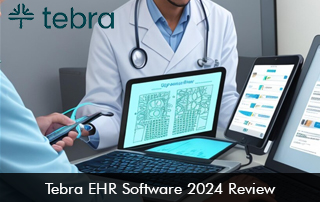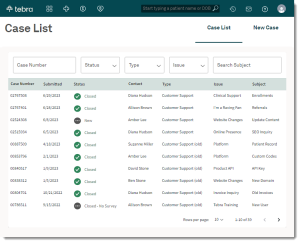EHR software has become indispensable in the medical field. They streamline operations, enhance patient care, and ensure compliance with healthcare regulations. Among the myriad options available, Tebra EHR Software has emerged as a significant player in 2024. This review will delve into its features, usability, benefits, and areas for improvement, providing a comprehensive overview of what Tebra EHR offers to healthcare providers.
Overview of Tebra EHR Software
Tebra EHR Software is designed to cater to the diverse needs of medical practices, ranging from small clinics to large healthcare institutions. It integrates various functionalities, including patient management, appointment scheduling, billing, and clinical documentation, into a single, cohesive platform. Tebra emphasizes user-friendliness and interoperability, making it a popular choice for healthcare providers seeking an all-in-one solution.
Key Features of Tebra EHR Software
User-Friendly Interface
Tebra EHR Software stands out with its intuitive and easy-to-navigate interface. The dashboard is customizable, allowing users to arrange widgets and shortcuts according to their preferences. This flexibility ensures that healthcare providers can access frequently used features quickly, enhancing overall efficiency.
Clinical Documentation
The clinical documentation module in Tebra EHR is robust and designed to streamline the process of recording patient encounters. It includes customizable templates, voice recognition, and AI-assisted note-taking capabilities. These features significantly reduce the time spent on documentation, allowing clinicians to focus more on patient care.
Tebra EHR Software Interoperability
Tebra EHR excels in interoperability, seamlessly integrating with other healthcare systems and third-party applications. This capability ensures that patient data can be easily shared and accessed across different platforms, promoting coordinated care and reducing the risk of errors.
Telehealth Integration
In response to the growing demand for remote healthcare services, Tebra EHR includes a comprehensive telehealth module. This feature allows providers to conduct virtual consultations, manage remote patient monitoring, and communicate securely with patients via video calls and messaging.
Billing and Revenue Cycle Management
The billing module in Tebra EHR is designed to simplify the revenue cycle management process. It includes automated claims processing, real-time eligibility verification, and integrated payment processing. These tools help reduce administrative burdens and improve cash flow for medical practices.
Tebra EHR Software Patient Portal
Tebra EHR includes a patient portal that enhances patient engagement and satisfaction. Patients can schedule appointments, access their medical records, request prescription refills, and communicate with their healthcare providers through the portal. This feature empowers patients to take an active role in managing their health.
Benefits of Tebra EHR Software
Enhanced Efficiency
Integrating multiple functionalities into a single platform reduces the need for separate systems, streamlining workflows and enhancing overall efficiency. The user-friendly interface and customizable dashboard further contribute to time savings for healthcare providers.
Improved Patient Care
Tebra EHR’s clinical documentation and interoperability features ensure that patient information is accurate, up-to-date, and easily accessible. This comprehensive view of patient data enables healthcare providers to make informed decisions, ultimately improving patient outcomes.
Tebra EHR Software Regulatory Compliance
Tebra EHR is designed to comply with various healthcare regulations, including HIPAA and MACRA. It includes features such as audit trails, data encryption, and secure messaging, ensuring that patient data is protected and that practices meet regulatory requirements.
Financial Performance
The billing and revenue cycle management tools in Tebra EHR help optimize financial performance for medical practices. Automated claims processing and real-time eligibility verification reduce denials and delays, while integrated payment processing ensures timely collections.
Areas for Improvement
Learning Curve
While Tebra EHR is user-friendly, some users may experience a learning curve, particularly those transitioning from different EHR systems. Comprehensive training and support resources can help mitigate this issue, ensuring a smoother transition for new users.
Tebra EHR Software Customization Limits
Although the platform offers customization options, some users have reported limitations in certain areas. Expanding customization capabilities, particularly in clinical templates and reporting, could further enhance user satisfaction and adaptability to specific practice needs.
Tebra EHR Software Cost
Tebra EHR is a feature-rich platform, but its cost may be a consideration for smaller practices with limited budgets. Offering tiered pricing plans or scalable solutions could make the software more accessible to a broader range of healthcare providers.
User Feedback
User feedback is a crucial aspect of evaluating any EHR system. Tebra EHR has generally received positive reviews from healthcare providers. Users appreciate the intuitive interface, comprehensive features, and excellent customer support. The telehealth integration and interoperability capabilities are particularly praised, as they address the current needs of the healthcare industry.
However, some users have noted the initial learning curve and customization limitations as areas for improvement. Overall, the feedback suggests that Tebra EHR is a reliable and effective solution for managing healthcare operations, with room for enhancements to meet diverse user needs.
Conclusion on Tebra EHR Software
In 2024, Tebra EHR Software will continue to be a robust and versatile solution for healthcare providers. Its user-friendly interface, comprehensive feature set, and focus on interoperability make it a valuable tool for enhancing efficiency, improving patient care, and ensuring regulatory compliance. While there are areas for improvement, such as the learning curve and customization limits, the overall benefits of Tebra EHR far outweigh these challenges.
For medical practices looking to invest in an EHR system that can adapt to their evolving needs and support their growth, Tebra EHR Software is undoubtedly worth considering. As the healthcare landscape continues to change, having a reliable and innovative EHR system like Tebra can make all the difference in delivering high-quality patient care and achieving operational excellence.









